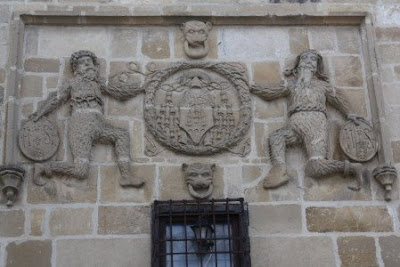After Córdoba we had one last pair of stops before heading back to Barcelona: Úbeda and Baeza, two towns less than 10 kilometers from each other. The period of Moorish rule was less important for these towns than for most places we visited. These towns flourished in the 16th century when nobles who fought in the Reconquista settled there. The buildings of both have a distinct Renaissance flavor.
[An historical footnote: When Christian forces captured Baeza in the 13th century, Moors living there were forced to leave. Many fled to the Albaicín hill in Granada. One story is that the hill took its name from Albayyasin, that which belongs to the people of Baiza.]
We stopped first at Úbeda, and were a bit underwhelmed. It didn't quite live up to the two-star expectations Michelin had created, although it did have a few interesting sights. The austere Renaissance Palau de las Cadenas (chains).
 The Sacra Capilla del Salvador, whose interior is much more exuberant than the exterior (but no pictures were allowed).
The Sacra Capilla del Salvador, whose interior is much more exuberant than the exterior (but no pictures were allowed). [Can anyone tell me why some churches forbid picture-taking as disrespectful, while others are not a bit offended by any and all snapping away?]
[Can anyone tell me why some churches forbid picture-taking as disrespectful, while others are not a bit offended by any and all snapping away?]Last and perhaps least, in the same category of the decidedly odd as the Palacio del Marqués de Salviatierra in Ronda, there was Casa de los Salvajes (Savages).
 In case you wondered, Michelin says only that the two creatures are holding up a bishop's crest. That hardly seems to me a complete explanation or justification of the design, but that is the best I, or apparently Michelin, can offer.
In case you wondered, Michelin says only that the two creatures are holding up a bishop's crest. That hardly seems to me a complete explanation or justification of the design, but that is the best I, or apparently Michelin, can offer.On to Baeza, which delighted as much as Úbeda disappointed. It was the perfect final stop - a small town with delightful sights to enjoy at a relaxed pace after the great monuments of Granada, Sevilla, and Córdoba.
Our first stop was a cold beer and late midday meal at a cafe on the (relatively) modern Plaza de la Constitución. (Lots of garlic and quite tasty: a local peasant soup with literally spoonfuls of garlic slices, followed by rabbit in garlic sauce.)
 Then on to our self-guided walking tour. First stop, the 16th century
Then on to our self-guided walking tour. First stop, the 16th century Plaza del Pópulo with its Fuente de los Leones. The statues of the fountain may look a bit worn, but while the fountain is the 16th century it was constructed with statues from a nearby Roman (previously Carthegenian) town.
Plaza del Pópulo with its Fuente de los Leones. The statues of the fountain may look a bit worn, but while the fountain is the 16th century it was constructed with statues from a nearby Roman (previously Carthegenian) town.To the left of the fountain is the handsome Renaissance facade of the Antigua Carniceria - in other words, a very grand butcher's shop.
 At the far end of the Plaza another 16th century building, the Casa del Pópulo (originally a civil court and chancery), and an adjoining arch and gate. The memorial arch was constructed for a visit by Charles V in 1526. The arch had been built for Charles five years earlier as an act of submission after he prevailed in his war against the insurgent Communeros, who were supported by many nobles of the town.
At the far end of the Plaza another 16th century building, the Casa del Pópulo (originally a civil court and chancery), and an adjoining arch and gate. The memorial arch was constructed for a visit by Charles V in 1526. The arch had been built for Charles five years earlier as an act of submission after he prevailed in his war against the insurgent Communeros, who were supported by many nobles of the town. [Obviously this and some other pictures here were taken later, in the evening, when we did another tour.]
[Obviously this and some other pictures here were taken later, in the evening, when we did another tour.]A hundred fifty yards away is another plaza. In front of the Catedral Santa Maria is the Fuente Santa Maria in the shape of a small triumphal arch.

 Behind the church are picturesque little streets and gates.
Behind the church are picturesque little streets and gates.Another 100 yards or so brought us to the Plaza Santa Cruz and the Palacio de Jabaiquinto, with its elaborate front.

 With various odd figures clinging above the main door.
With various odd figures clinging above the main door.A short walk to the edge of town gave us a view south over the valley to the mountains beyond.
 Olives are king in Jaen province, where Baeza is located. Look closely: all those rows of crops visible across the valley are countless olive trees.
Olives are king in Jaen province, where Baeza is located. Look closely: all those rows of crops visible across the valley are countless olive trees. We spent a thoroughly delightful afternoon in Baeza, enjoying the sights and just enjoying the town. Adding to the pleasure was the Hotel La Casona del Arco, the most enjoyable hotel we stayed in, located in an old building next to one of the old town gates.
We spent a thoroughly delightful afternoon in Baeza, enjoying the sights and just enjoying the town. Adding to the pleasure was the Hotel La Casona del Arco, the most enjoyable hotel we stayed in, located in an old building next to one of the old town gates. A perfect ending to our trip.
A perfect ending to our trip.
No comments:
Post a Comment